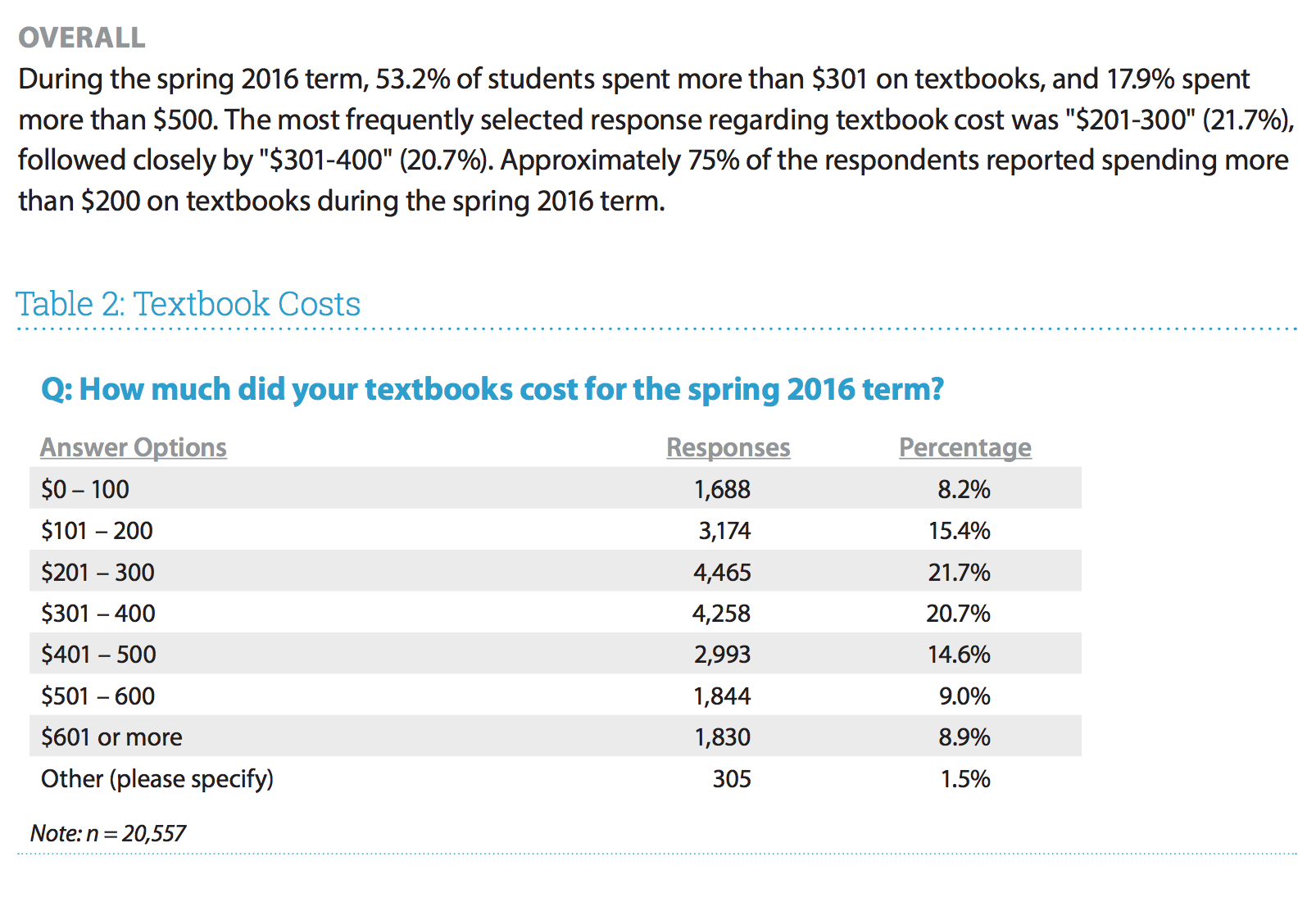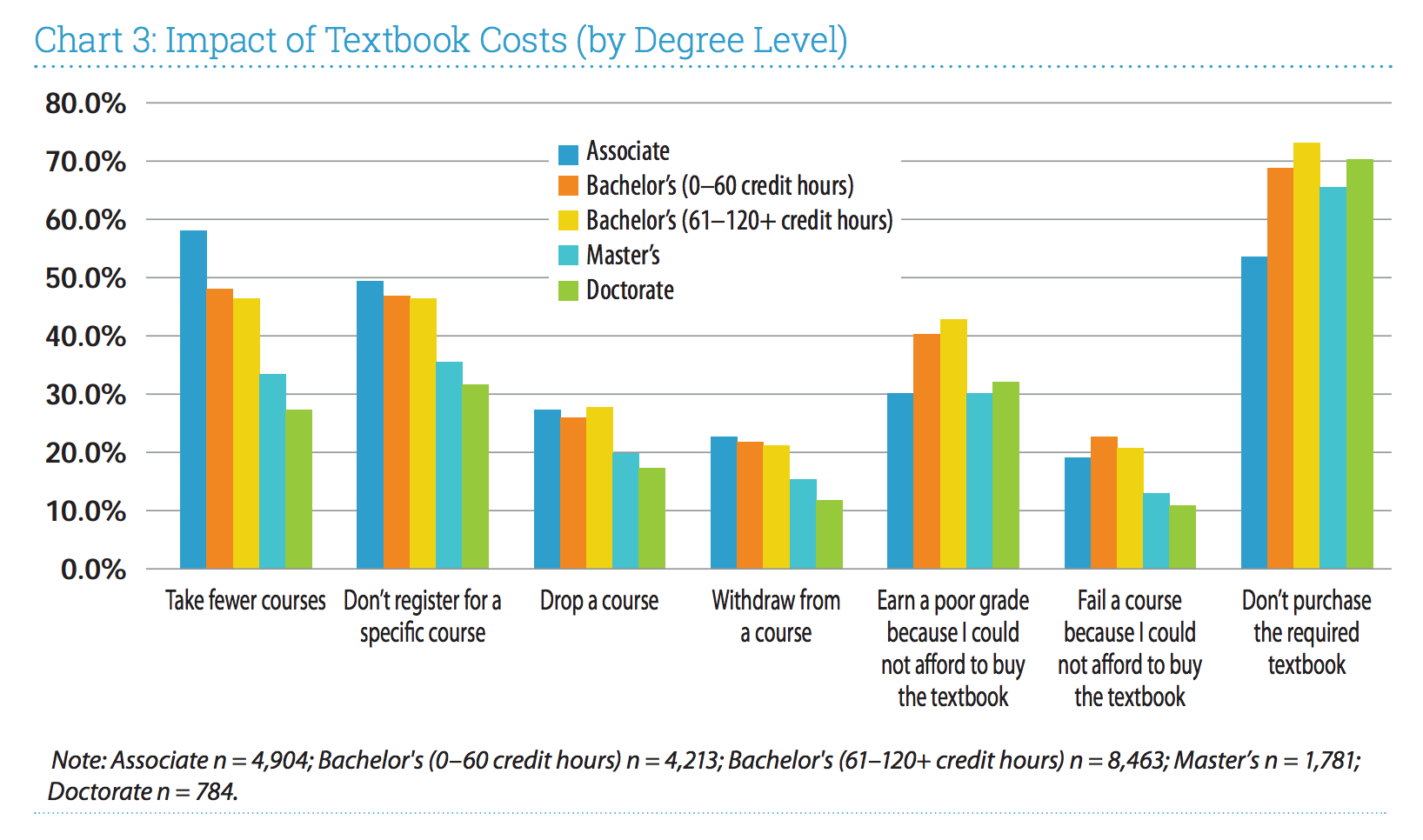As long-time readers know, I strongly believe that the national discussion about the costs of textbooks and course materials is more productive when we focus on actual student behaviors and impacts, rather than artificial numbers used by many organizations. There may be short-term benefit from claiming or implying that the average college student spends $1200 or more per year on textbooks, but the reality is closer to $650. See “How Much Do College Students Actually Pay For Textbooks?” for more details, thanks in particular to information from NACS.
The second-best source available on actual student expenditures on textbooks and course materials is the bi-annual survey from the Florida Virtual Campus (FLVC), which serves Florida’s state colleges, universities, and K-12 districts. Two weeks ago they released the third survey “2016 Student Textbook and Course Materials Survey”, a study of more than 22,000 students in the public colleges and universities. This report is particularly informative for asking questions about the impact of textbook costs – what do students end up doing. That is the interesting question.
The whole report is worth reading, but I’d like to highlight two key points. The first is confirmation that the average actual spending on college textbooks is in the $600 – $650 per year range. In the FLVC survey, students spend just over $300 in one semester on textbooks.

Students, of course, are spending less on textbooks not because they are getting cheaper but because they are finding alternatives. In Michael’s post “The Great Unbundling of Textbook Publishers”, he described this dynamic.
So the textbook publishers have been diversifying out of print in higher education for some time, even though it has been a slow process and even though many of them are still pretty book-centric in their thinking. But that process is going to accelerate because we are reaching an inflection point in the commodification of content. Students are getting better and better all the time at avoiding buying the textbook. Meanwhile, market options proliferate and improve. Textbook rental companies are getting four or five semesters of rental out of one book, which is four or five semesters’ worth of sales that publishers are missing. Publishers have responded by offering their own rental services and low-priced options, but these are all defensive actions.
But this alternative behavior is not all good, and in fact the FLVC survey shows just how harmful textbook pricing is. Students were asked:
Q: In your academic career, has the cost of required textbooks caused you to:
[list of options, check all that apply]
Their answers to this question have been fairly consistent with previous surveys, with this year’s results:

This chart not only shows the largest negative impact of textbook pricing falls on students seeking a two-year degree, with graduate students on the opposite end. Students choose to not take courses (or drop out, or fail) due to textbook pricing at a very high rate.
Implementing new models that directly address the costs of textbooks can directly impact student success outcomes. It’s good to have this report from Florida to provide harder numbers to back up assumptions. Kudos to FLVC for putting out this report.
Florida Virtual is a very inexpensive way to get educated, so that its students are price sensitive makes sense. That said, it still would cost a student – a Florida student – in excess of $3,000 in tuition and fees for a year’s worth of courses. These costs, of course, are subsidized by the taxpayers, and would otherwise be higher.
So the – unsubsidized – course materials cost is 20% of tuition and fees (at a very inexpensive institution.) I often wonder what all the fuss is about . . .
GalleryP – FLVC “conducted a Student Textbook and Course Materials Survey with more than 22,000 students of Florida’s 40 public colleges and universities”. This is a study of all public colleges & universities in the state – not just at FLVC.
What the fuss is about? Look at Chart 3 above. I’m not trying to be dismissive here; but students are making decisions that are harmful to educational success (graduating within reasonable time, course grades, etc) based on the costs. If institutions and states want to see an improvement in student success rates (and they almost all do, by the way), then the data is quite clear that this issue is a big lever.
Thanks for correcting me. At U of Florida, tuition and fees are double what they are at Florida Virtual, so the course materials costs are 10% of that of tuition and fees. If students really are making decisions about their educational choices based on course materials costs, it seems to me they are not seeing the forest.
__Oct 21 TJ Bliss tweeted this survey’s Key Finding 1:
“The high cost of textbooks is negatively impacting student access, success, and completion.”
In response, I tweeted a suggestion:
“Survey data should include student’s budget and itemized fixed and discretionary expenditures for an analysis of textbooks’ impact”
My tweet-sized suggestion was too brief I suppose, but there was swift reaction . . . “You are blocked from following @tjbliss and viewing @tjbliss’s Tweets.”
This Survey is an opportunity to gain specific data that would be useful and actionable – “The high cost of textbooks [specific data] is negatively impacting student [specific data] access, success, and completion.”
“In your academic career, has the cost of required textbooks caused you to. . ” may be a leading question when the textbook price is unknown [$50-$100-$300?] or in assuming the cost is “too much” “can’t afford” – for some Students the response likely is “I had money but didn’t see the value in making the purchase”
“The 2016 Student Textbook and Course Materials Survey was conducted to help education leaders and policy makers better understand how textbook and course material costs are impacting student perceptions, academic decisions, progress, and perceived value of educational resources.”
To be able to achieve these objectives the survey should seek useful data on the respondents’ financial circumstances, priorities and perceptions impacting their purchasing decisions, given that there are multiple demographic profiles to define within this group of 22,000 Students.
Free textbooks is not the one and only solution.
Don, I understand your point, but . . .
No survey is perfect, and there are always ideas to gather additional information. The FLVC survey is laudable by getting broad responses (22k) while sharing their methodology. I strongly suspect that if the survey asked for “respondents’ financial circumstances, priorities and perceptions impacting their purchasing decisions”, they likely would not have received so many responses. Meanwhile, the report openly shares the methodology and questions so that people can do as you have and note the limitations of the results. Point is – this survey is probably the best one I have seen with broad responses to questions on impacts. Useful data but not perfect.
As for referenced conclusion that free textbooks are the one and only solution. I agree with you, but that seems stated like taking down a straw man. Or perhaps in response not to the report or this post but to your former Twitter connection.
__Thanks, Phil, hopefully legislators see there is an opportunity in a survey to ask follow up questions in order to gain relevant information about student purchasing behaviour which may reveal a range of ways to increase student success. Perhaps, if all course syllabi were created to be helpful to students seeking savings by offering them options to the Faculty-recommended reading materials [aka required textbook] via a comprehensive list of reviewed and rated OER and alternative editions of commercial textbooks. Students and TA’s could [pay-it-forward] help their Faculty by doing the time consuming research throughout the semester to discover alternative resources and suggested materials to be Faculty-vetted and listed within their Course Syllabus.
__Hi Phil, thought you’d likely be interested in the nature of follow up questions that were asked of Students Surveyed at Oregon State University OSU in 2007, as described in this paper – Student Strategies for Coping with Textbook Costs and the Role of Library Course Reserves – Anne Christie, John H. Pollitz, and Cheryl Middleton _ https://minds.wisconsin.edu/bitstream/handle/1793/38662/PollitzStudentTextbooks2009.pdf _ they also explain why they decided not to survey first year Students
Don, I’m reading now but grumbling about the heavy PIRG references on cost data. Grumble, grumble . . .
Don, I could see a reasonably compact survey that combines the OSU and FLVC approaches:
1. Did you buy or not? – both surveys
2. Why did you buy or not buy (factors)? – OSU
3. What did you do for cases where you did not buy? – OSU
4. What was the impact of not buying? – FLVC
That would provide even more useful info. Thanks for finding this.
Are your thoughts on 600-650 price for the year based on 2 semesters? There are universities that have 3 full semesters plus summer term. The summer can be a full term or broken down to 2 sessions like the classes are expedited and done in half the time.
Winnie – yes, the $600 – $650 is based roughly on two-term estimates. I am not sure how the major surveys (NACS and FLVC in particular) handle tri-mester schools. Good question.